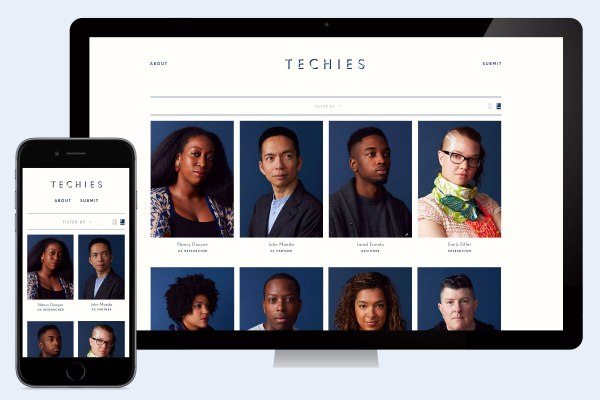Techies Project, a photo and interview project that launched today, explores the personal stories and experiences of hundreds of underrepresented people in tech. You might recognize people like Tristan Walker, founder and CEO of Walker & Company Brands, and John Maeda, partner at Kleiner Perkins Caufield Byers. You will probably also learn about someone doing amazing work in tech whom you’ve never heard of before. The intent is to show the world what the tech industry actually looks like, tell the stories and hardships of underrepresented people in tech, and give other underrepresented people a chance to see themselves in tech.
“There’s an experience that comes from seeing the word ‘techies’ and knowing that it has turned into this kind of derogatory, loaded term that kind of makes people’s skin crawl now,” Helena Price, creator of Techies Project, told me. “Now people hear it and they sort of cringe. Everybody has an image in mind of what that word is. For them, to see that word, expect one thing, and then see a grid of images that don’t look like what they expect is an experience in itself. And if that’s all they see and then they walk away, I feel kind of satisfied.”
The project focuses on everyone except for straight white dudes, Price said. Although there are white men in featured in the project, as well as straight men, she didn’t focus on anyone who is both of those things. The project explores the numerous, intersecting identities of people, including race, gender, sexuality, age, disability status, parental status, education level, immigrant status and more.
[gallery ids="1300513,1300512"]
The platform lets you sort by all types of identities so that you can easily read the story of a first-generation, transgender developer in tech. Right now, there’s a misconception that only white, cis men can succeed in tech. With Techies Project, Price hopes that people from underrepresented backgrounds can see people like them who are succeeding in the industry, despite the struggles or microaggressions they may be facing at work.
“I’ve always wanted to do this format of project,” Price said. “I’m super into oral histories and like people’s origins stories and I occasionally did work in that vein when I worked in startups. I wanted to explore greater concepts just through people sharing their own life experiences, and this idea of libraries of human experiences is really cool to me. So I always knew this was a format of work I wanted to take on. What the first subject matter was another question.”
Price worked in tech for a few years and describes herself as a recovering techie. She says that a lot of the opportunities that have come her way as photographer happened because of her experience in tech. But, she didn’t have the most positive experience in tech and, as a result, has a complicated relationship with it.
“So, I wanted to do a project that explored other people’s complicated relationships with tech and that’s where the impetus for this came from,” Price said.
Meanwhile, she said, it’s pretty obvious that the tech industry is in a weird place right now, where a lot of things are coming to a head.
“From the outside, people kind of hate tech right now. So that’s a thing. For me, that’s obvious to everyone I think. And internally, there’s definitely some clashing that’s happening where people, one side still is very adamant about tech being a meritocracy and ‘We want diversity but where are they?’ There’s that chatter but then there’s people who are starting to be open about their experiences in tech. Mediums helping with that, Twitter’s helping with that.”
With all of these things bubbling up, Price wanted to use her photography skills to document the state of tech in 2016. So, she put out a call for submissions in January of this year and received over 500 of them. Although there are no big takeaways from the project, Price said, her goal is to create a scenario in which she proposes new questions to the current situation and conversations around diversity in tech.
“I wanted to show the outside world that tech is a little different than what they think it is and there are a lot of people here with good intentions,” Price said. “Internally, I wanted to provide some food for thought for people who really do think it’s a meritocracy. There are people who are incredibly proficient and have gone through unthinkable challenges to get here and that often is not even considered in measuring someones worth or potential as an employee. I’ve been really interested in exploring that idea of, ‘What have you been through to get here?’ and ‘Why is that not considered a factor in your potential?'”
Something Victor Roman, a senior software engineer at SolarCity, said really resonated with Price.
Because how can we measure someone’s accomplishments without recognizing that not everyone starts in the same place on the race track. Some people start a mile or two back, and then when they don’t finish in first place, we say, “Well, you didn’t do very good.” When the reality is they ran faster, and they ran longer than any of those other people. The person who ran first place, they just started at a different location. And I think that’s an important part of this conversation, about what is that mile or two back, what makes up that distance.
That analogy “is so fucking strong,” Price said. A couple of things the tech industry lacks are the conversations and appropriate actions around where people came from, and the challenges they’ve had to overcome to get to where they are today.
By the end of the year, Price hopes to have double the number of interviews on the site. Moving forward, Price hopes to turn this project into a book — one that serves as a snapshot in time of tech in 2016.
